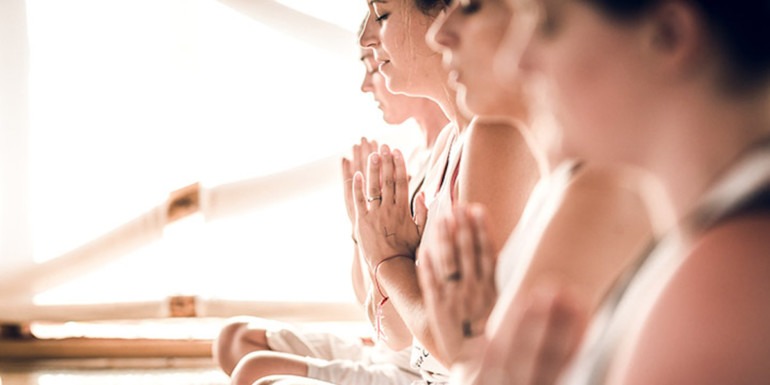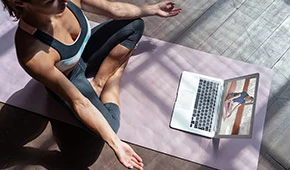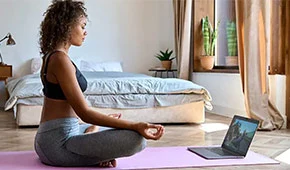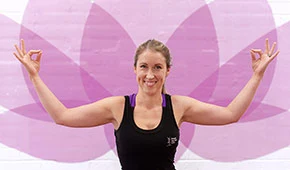
Yoga for anxiety and panic attacks – The somatics and bioenergetics of anxiety and panic attacks, and how asana, pranayama and meditation can bring about positive change.
By Barbara Mahon
“In the minds of many people in the West, Yoga is associated primarily with strange contortions of the body, but the major focus of Yoga is actually the modification of one’s relationship to the world. It is a complete system of therapy, which includes developing awareness and control of the physical body, emotions, mind and interpersonal relations” Swami Rama – Yoga & Psychotherapy, the Evolution of Consciousness
A rabbit rests amongst the foliage in a forest. It is quivering and shaking. A fox has been hunting it through the fields, but it has had a lucky escape. It is quivering in order to release the tension of the chase from its body. Once the quivering subsides, the rabbit completes the process by thumping its hind legs on the ground and begins jumping, as if for joy. According to Alexander Lowen, the American Psychotherapist and creator of Bioenergetic Analysis, it is the rabbits’ natural reaction to release the fear it has felt and to bring its body back to equilibrium. Unlike rabbits, humans no longer have a natural reflex to release tension and anxiety from their bodies after a stressful episode. Instead we are likely to hold the tension in our bodies. Often the tension becomes trapped in the shoulders or in the core and become part of the “personality” of the persons’ body.
This article will examine the nature of anxiety and the panic attacks which can manifest as a result of extreme anxiety. In the Western world today, anxiety and panic attacks are very common ailments and are treated in a variety of ways, both holistically and medically. Holistic treatments include acupuncture and massage, while medical treatment centers on psychotherapy and drugs. Yoga can support these treatments and the ways in which it can do this will be discussed here. While anxiety is an emotional rather than a physical ailment, it is clear that it can be held in the body in a physical manner. Somatics is an area of study which examines how emotion is held in the body. The first section of this article will focus on outlining how somatics relate to anxiety-based conditions and panic attacks. Following on from this, the practice of Yoga asana, meditation and pranayama will then be considered in relation to the alleviation of anxiety and panic attacks.
We will then conclude with an outline for an anxiety-releasing Yoga workshop, designed for those suffering from medium to acute anxiety and panic attacks, based on a yin Yoga, restorative sequence which draws heavily on a wide range of props to provide a restful class. The main focus of the class will be to learn to go inwards in order to connect with the body and to experience control of the breath as a way of controlling the mind. The postures are combined with meditation and pranayama.
What is anxiety and how do panic attacks happen?
Everyone, at some point in their lives has felt anxiety. It is the butterflies you feel in your stomach when you’re going to an interview, or what spurs you on to finish a work assignment on time for a deadline. Anxiety is an emotion which can serve us well. It can alert us to danger and it can help us to get things done. However, when a person becomes consumed with worries and fears, resulting in extreme anxiety which debilitates them and prevents them from enjoying life, then remedial action can alleviate the extremes.
The symptoms of anxiety can include dizziness, nausea, shortness of breath, inability to sleep and irritability. It can be linked to depression, insomnia and alcohol abuse, among other conditions. Anger and low self-esteem can also be connected to it.
Panic attacks are a manifestation of extreme anxiety and can come on very quickly with little or no warning. They are an exaggeration of the body’s natural response to fear, stress or excitement. A person having a panic attack will find that they are breathing heavily, their heart will be racing and they will be sweating. They may feel that they are about to black out. They will feel physically out of control and may think that they are having a heart attack or even that they are about to die (Mind, the Mental Health Charity, 2012). Panic attacks can also occur during the night, which can be a particularly frightening experience for the person. Most panic attacks last for between 5 and 20 minutes. A person may have one or two panic attacks and never experience another. Or they might have attacks once a month or several times each week. For some people they seem to come without warning and strike at random.
The question remains, why do some people feel more anxious than others? Why do some suffer from panic attacks and others do not? In Ayurveda, it is said that those of a vata constitution will be more prone to anxious feelings and they are advised to seek out “grounding” foods and activities. In more general terms, it may be that some people are more prone to worry than others, or it can be because of their personality, current circumstances, their past or their childhood experiences. It could be a mixture of these things. Something distressing could have happened to the person in the past. They may have been unable to deal with their emotions at the time and so they may become anxious about facing similar situations again, in case they bring up the same feelings of distress. Feeling anxious could also be something which was learned in early life, for example, a family may have tended to see the world as hostile and dangerous and the person has learned to respond in the same way.
Other triggers for anxiety can include caffeine, excess sugar, poor diet, drug misuse, exhaustion and stress. The side effects of certain medication can also mimic and trigger symptoms of anxiety.
How is anxiety held in the body? – Somatics & Bioenergetics
As Yoga teachers and other practitioners will be aware, emotional releases are a common feature of asana practice for students. The realignment of the body through asana practice and the alteration of a person’s posture can allow them to release emotion and view the world in a different manner. It is said that it is possible to read each person’s “story” from their posture. The physical state is an embodiment of the mental state. For example, a person whose shoulders are habitually back and down, opening the chest is open and receptive to the world, while a person whose shoulders slope inwards may feel that they have the world on their shoulders.
The area of somatics and bioenergetics, which is informed by the work of Wilheim Reich and Alexander Lowen (Bioenergetic Press, 2012), examines how the body holds and manifests emotions in its structure and alignment. Holding the body in a certain way can provoke or accentuate the feelings or the thoughts that are associated with it. It has been suggested (Swami Rama, Ballentine, Swami Ajaya, 1976) that a body posture which has become habitual, beginning as a reaction to a certain mental state, may actually come to sustain and perpetuate that state. Posture and body habits come, not only to reflect character, but to actually sustain it and so may hinder growth and evolution.
In his article, “The Dynamics of Yoga” (Himalaya Yoga Valley, 2012) Godfrey Devereaux states: “All of our fears, hopes, memories and dreams can be read in the structure and activity of our bodies”. He continues by describing how anxiety manifests in two main physical ways in the body – through the breath and through the muscles of the body. The breath quickens and the body becomes tense. Much of the tension is held in the shoulders and also in the core.
He goes on to state that by teaching a person to control their breath, for example, through Pranayama, and helping them develop a greater sensitivity to the alignment of their body, they can begin to become more aware of their anxiety levels and take positive action so as to avoid the anxiety increasing. This would thereby potentially help avoid a panic attack.
Meditation and Pranayama for anxiety and panic attacks
As mentioned above, breath plays a very significant part in anxiety and panic attacks. Anxious breathing occurs disproportionally in the upper chest and doesn’t fully engage the diaphragm. When the diaphragm contacts, it descends, creating more space in the chest and lowering the pressure in the lungs so that they can draw in more air (McCall, 2007). Some people who are anxious have the sense that they can’t take in a full breath, increasing the anxiety.
A number of studies (Mc Call, 2007) have shown that yogic breathing is an effective method of combating anxiety. Learning pranayama techniques to control the flow of the breath, such as Nadi Shodana (alterate nostril breathing) can be hugely beneficial as it slows the breath and balances the two hemispheres of the brain. In Deergha Swasam (three part breath), students are instructed to breathe slowly and deeply while envisioning that they are filling their lungs from bottom to top—first by expanding the abdomen, then the middle rib cage, and finally the upper chest (Cummins, 2012). When exhaling, students envision the breath emptying in reverse, from top to bottom, pulling in the abdomen slightly at the end to empty the lungs completely. It can be useful to instruct students to use this technique at night, before sleep to help ensure a restful night.
Watch: Pranayama and Meditation with Lalit
Consciously slowing the breath while filling and emptying the lungs during a period of stress counters a number of physiological components of stress while reducing feelings of anxiety. Increasing the length of exhalations relative to inhalation has a similar effect. It has also been shown that training in relaxed diaphragmatic breathing reduces the frequency of panic attacks (McCall, 2007).
Meditation, especially when it is combined with pranayama, has also been shown to bring about a reduction in anxiety in studies (Swami Rama, Ballentine, Swami Ajaya, 1976). It can be viewed as a process of replacing anxiety and distractions with relaxed focus. In the Yoga Sutras of Patanjali, it is stated, “Dhyana heyah tad vrttayah” –“Meditation removes disturbances of the mind” (Yoga Sutra II.11) Recent research, (McGonigal, 2012) shows that the benefits of meditation run deep, even as far as increasing the amount of grey matter in the brain and changing the way that the brain operates. People who meditate regularly enjoy better levels of concentration, their stress levels are lower and they are better able to manage their emotions.
When working with people suffering from anxiety, Yoga teachers should keep in mind that the activity of Yoga asana may better occupy an over-anxious mind than the meditation space, where it may be more difficult to avoid anxious thoughts. Meditation can be introduced as a fully guided practice, with a focus on breath awareness, for example.
Asana practice and anxiety and panic attacks
In a study (McCall, 2007) conducted in 1984 the Yoga Biomedical Trust in London surveyed 2,700 people who were practicing Yoga in order to help alleviate symptoms of various conditions. To be included, participants had to have practiced Yoga for at least two hours a week for a year or longer. Of the 838 people in the group reporting with anxiety, 94% reported that Yoga helped them.
By applying the theory of somatics, we can begin to understand how asana practice, by gradually modifying the body’s posture, can bring about a change in a person’s mentality. Asana practice allows the person to really get to know their body. Each time a teacher says “release the shoulders”, or physically adjusts the shoulders down and back, for example, a person will become a little more aware of how tense their habitual posture and will gradually learn to release the tension on their own. This in turn will help them to be less anxious in their day to day life as they become more and more aware of their tensions and learn how to let them go.
According to Timothy McCall (2012), a good asana practice will burn off the nervous energy that can contribute to anxiety. He goes on to say that the regular practice of both asana and pranayama leads to greater internal sensitivity, which can allow students to detect the first signs of anxiety or a panic attack and respond using the techniques they have learned in Yoga class. An increasing number of doctors and therapists now recognise the benefits of Yoga and are more likely to prescribe asana as a non-medicating option for patients. The key for a student who wishes to manage their anxiety with techniques learnt in class is to take action as soon as they feel anxiety beginning to mount. Even taking five minutes to practice nadi shodana and to adjust their posture can make a difference to how they are feeling.
Being taught to use the breath with movement while practicing the Yoga postures will further help to focus and calm the mind. An asana sequence completely focused on uniting breath with movement will bring on a meditative state where all thoughts, including anxious ones, are absent and the person will enjoy a very relaxed state (McCall, 2012). Accessing this state will make the person realise that their habitual anxious state is not one which is permanent and which can in fact be managed or even removed by practicing asana on a regular basis either in class or by developing a self-practice.
Restorative Yoga workshop for anxiety and panic attacks
The following is a basic outline for a two and half hour workshop targeted specifically to those who suffer from acute anxiety and panic attacks. The main goals of the workshop are to release tension from the body – emotional, mental and physical – through a gentle yin Yoga & restorative-based sequence. Yin Yoga is a slow, meditative form of Yoga. The focus is on stretching the connective tissue, (Grilley, 2012) each of the poses being held for 3-5 minutes. The students will also be taught techniques which they can use on a daily basis in order to help manage their anxiety. The main areas of focus are the shoulders, core, hips and hamstrings, which are the areas which are most likely to hold tension. As many of the postures as possible are to be practiced using props for the restorative qualities. The pranayama techniques of sandbag breathing (technique outlined below), Deergha Swasam and Nadi Shodana can be taught as part of the class, combined with a short guided meditation and savasana. .
- Savasana with Sandbag breathing (Mc Call 2007) –5-10 minutes – Lie in savasana with a blanket or cushion under the head and place a sandbag on the upper abdomen. Use the diaphragm to breathe and to make the exhalation equal to the inhalation. This demonstrates to students how to regulate their breath and brings awareness to the diaphragm.
- Makrasana -Crocodile breathing – 6-10 minutes – Lie on the belly, feet apart. Rest the forehead on folded arms. Bring the awareness to the breath and inhale and exhale, feeling the abdomen rise and fall. This again brings awareness to the breath and helps the student to learn to breathe into the diaphragm rather than breathing in the chest, as anxious people are prone to do.
- Rocking chair – 10 to 20 repetitions – Coming to sitting, bring the hands under the thighs and bend the knees. Rock back and forwards, exhaling back and inhaling forwards. This releases tension from the spine and from the core.
- Sarvangasana – Using bolsters, cushions or blankets, come to Sarvangasana, shoulder stand, against the wall. Inverting the body draws blood to the head and relaxes the nervous system.
- Matsyasana – A gentle backbend to open the heart centre and release tension from the core, which can be performed using a bolster or thickly rolled blanket under the spine, with the head resting comfortably on the floor
- Janu Sirsasana – use a cushion under the hips for support in this seated posture which will release tension from the hips.
- Vrksasana – Come into tree pose while supported by the wall using the thumbs. Balancing postures are good for focus and concentration while also building confidence and awareness in the body.
- Balasana – Use a bolster to support the chest, resting the head to one side and bringing the arms alongside the hips. This posture allows for deep relaxation for the entire body.
- Closing Savasana & visualisation – 7-8 minutes minimum in corpse pose, visualising the release of all tension from the body and going inwards to feel the sensations of absolute relaxation and reminding the students that they can access this place whenever they need to by practicing the techniques taught to them.
- Meditation & pranayama – A guided 7 minute meditation which can end with two minutes of the students repeating the mantra – “so ham” – son with the inhalation and hum on the exhalation, both silently, the intent being to rest in the sound of the mantra while being aware of other thoughts as they travel through the mind. Employing Chin mudra will help deepen the relaxation. Practice of Nadi Shodana and Deergha Swasam to teach relaxing pranayama which can be practiced at home.
Conclusion
It is clear that the area of anxiety and panic attacks is a broad one in that there is no one clear defined reason why people suffer from these conditions. But it is apparent from what has been put forth by this article that there are many effective and proven ways of helping sufferers through Yoga.
It has been explained here how the human body holds onto tension and emotions in certain areas of the body and the areas of somatics and bioenergetics have been considered. Unlike Lowen’s Rabbit, humans do not naturally know how to let go of tension and so it gets caught up in the body, causing disturbances. Asana, meditation and pranayama can all help to balance these emotions however and help the student to achieve a more balanced state of mind. These methods have been outlined in this article. There are however many other ways in which a Yoga teacher can help their students to deal with anxiety and panic attacks effectively. Mantras, Yoga nidra, sound healing, chakras, Yoga philosophy and nutrition based on ayurvedic principles are just some other areas which Yoga teachers could consider introducing their students to which could greatly enhance their lives, while allowing the student to find the methods best suited to them and their specific symptoms.
It is clearly apparent that Yoga is not simply a set of exercises which stretches and tones the muscles, but, as the Yoga sutras state, “Yoga citta vritti nirodhah”; “Yoga is the ending of disturbances of the mind” (Yoga Sutra I.2). Yoga is a scientific therapeutic system, as Swami Rama says, which, when practiced mindfully and with purpose, can powerfully change the physical and emotional make-up of a person in positive ways, which may well have the power to change the way in which they live their lives.
Barbara Mahon – Himalaya Yoga Valley Graduate
Barbara teaches at Yoga Hub in Dublin. You can follow her on Facebook (Barbara Mahon) and Instagram @bmyoga.
References
- Bioenergetic Press, 2012, The Teachings of Wilhelm Reich and Alexander Lowen [online] Available at: https://www.bioenergeticspress.com/theteachingsofwilhelmreichandalexanderlowen.aspx
- Coulter, David, 2006, Anatomy of Hatha Yoga, Delhi: Motilal Banarsidass
- Cummins, Claudia, 2012, Prescriptions for Pranayama [Online] Available at https://www.Yogajournal.com/practice/673
- Devereaux, Godfrey, c19?, The Dynamics of Yoga, Himalaya Yoga Valley YTTC Manual
- Dychtwald, Ken, 1977, Bodymind, New York: Pantheon Books
- Grilley, Paul, 2012, Yin Yoga [online] Available at: https://www.Yogajournal.com/practice/580
- Himalaya Yoga Valley, 2012, Yoga Teacher Training Manual, Mandrem
- Mc Call, Timothy , 2007, Yoga as Medicine, New York: Bantam Books
- Mc Call Timothy, 2012, Yoga for Anxiety and Panic Attacks [online] Available at https://www.Yogajournal.com/for_teachers/2390?print=1
- McGonigal, Kelly, 2012, Your Brain on Meditation [Online] Available at https://www.Yogajournal.com/health/2601
- Mind, The Mental Health Charity, 2012, Understanding Anxiety and Panic Attacks, [online], Available at https://www.mind.org.uk/assets/0001/8824/Understanding_anxiety_and_panic_attacks_2012.pdf
- Swami Rama, Ballentine Rudolphe, Swami Ajaya, 1976, Yoga and Psychotherapy – The Evolution of Consciousness, Pennsylvania: Himalayan Institute Press
- Yoga Journal, 2012, Yoga poses for anxiety [online], available at https://www.Yogajournal.com/poses/finder/therapeutic_focus/t_anxiety





